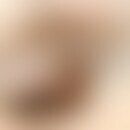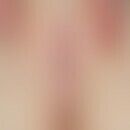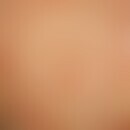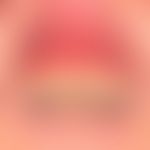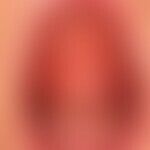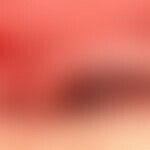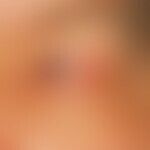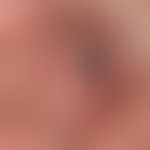Synonym(s)
HistoryThis section has been translated automatically.
DefinitionThis section has been translated automatically.
Rare, chronic, blistering autoimmune disease of the mucous membranes of the conjunctiva, mouth, pharynx, oesophagus, genitals and anus, leading to scarring and loss of function. Immunohistologically, the disease has identical findings to bullous pemphigoid and is probably a variant.
You might also be interested in
ClassificationThis section has been translated automatically.
Immunohistologically, 4 groups can be distinguished:
- Anti-epileprin Cicatrical Pemphigoid: Clinically, this type cannot be distinguished from the other variants.
- Ocular cicatricial pemphigoid: Patients with autoantibodies against β4-integrin as well as α6β4-integrin (see integrins below).
- Patients with autoantibodies to BP 180 (corresponding to bullous pemphigoid) and mucosal and cutaneous lesions.
- Anti-laminin 332 mucosal pemphigoid (about 20-30% of patients), which needs attention as paraneoplastic pemphigoid (35% of cases are associated with malignancies).
- Heterogeneous group, predominantly with mucosal involvement: pathogenesis regarding autoantibodies still unclear.
Occurrence/EpidemiologyThis section has been translated automatically.
Rarely. No ethnic predilection. Incidence (Western Europe): 0.08-0.2/100,000. inhabitants/year.
ManifestationThis section has been translated automatically.
Occurs mainly in older people, especially in women between the ages of 60 and 80. Rare onset in childhood. Diagnosis is often delayed, more than 1 year after initial manifestation.
LocalizationThis section has been translated automatically.
Frequency of infestation depending on localization:
- Oral mucosa: 85%
- Conjunctiva: 64%
- pharynx: 19%
- external genitalia: 17%
- nasal mucosa: 15%
- Larynx: 8%
- anal region 4%
- Esophagus: 4%
Less frequently
- Urethra
- Rectum
ClinicThis section has been translated automatically.
Onset of clinical manifestations with chronic, recurrent, painful and therapy-resistant erosive inflammation of the mucous membranes close to the skin. The predominant initial manifestation is a therapy-resistant, erosive stomatitis (DD pemphigus vulgaris). The initial manifestations very rarely affect the skin organ! Clinically, enanthema with fragile blisters appear, which lead to chronic, usually painful erosions or extensive ulcerations.
- Oral mucosa (100% affected): Recurrent, erosive, painful stomatitis with rapidly bursting, scarred healing blisters (blisters often undetectable) on the palate, cheeks and gingiva. Depending on localization: restriction of tongue movement, mucosogenic jaw impaction, tooth loss. After healing, possibly lichenoid leukoplakia.
- Eyes (80% affected): Recurrent conjunctivitis. The symptoms usually begin unilaterally, after 1-2 years there is usually bilateral involvement. There is a variety of clinical manifestations with the appearance of clear, rapidly bursting blisters, scarring shrinkage, entropion and trichiasis, synechiae between the bulbar and palpebral conjunctiva, restriction of eye movements, obstruction of the lacrimal duct with xerophthalmia. Eyelid closure is often impossible.
- Nasopharynx (30-40% affected), possibly also upper gastrointestinal tract: Encrusted ulcerations, fibrous adhesions up to obstruction of breathing, dysphagia, life-threatening stenosis of the esophagus or trachea.
- Genitoanal mucosa: blistering, synechiae, constricting scarring.
- Integument (30-50% affected; face, navel, mons pubis): bulging, in loco recurrent blisters on an erythematous base, formation of atrophic scars, possibly scarring alopecia.
- Special forms: scarring pemphigoid type Brunsting-Perry and scarring disseminated pemphigoid.
LaboratoryThis section has been translated automatically.
HLA-DQw7
Circulating anti-basement membrane antibodies are rarely detectable.
In contrast, IgA autoantibodies directed against BP 180 (BP230) are more frequently detectable.
Likewise, antibodies against the 168 kD antigen, which is only found in the buccal mucosa, can be found, and in patients with ocular infestation only, antibodies against the 45 kDa antigen can also be found.
HistologyThis section has been translated automatically.
Direct ImmunofluorescenceThis section has been translated automatically.
Linear IgG (more rarely IgA or IgM) and complement deposits (C3). The highest sensitivities are obtained for IgG, IgA and complement C3 at the basement membrane zone.
In the salt-split technique (see salt-split examination below), the antibodies are detected at both the epidermal and dermal basement membrane.
The IgG deposits are predominantly IgG4 and IgG1 subclasses.
Remark: It has been shown that examinations of non-lesional skin (i.e. 1 cm next to the lesion) provide better results than the examination of inflamed bulbar or tarsal conjunctiva! The biopsy of a blister can lead to false positive (Ig/C3 is deposited unspecifically) or false negative reactivity (Ig/C3 is proteolytically degraded).
Immunoelectron microscopy reveals immunoglobulin deposits in the lower lamina lucida and above the lamina densa, but also on the hemidesmosomes.
Indirect immunofluorescenceThis section has been translated automatically.
Circulating anti-basement membrane antibodies are rarely detectable.
In contrast, IgA autoantibodies directed against BP 180 (BP230) are more frequently detectable. Similarly, antibodies against the 168 kD antigen, which is only present in the buccal mucosa, are also found. In patients with exclusive eye infestation, antibodies against the 45 kDa antigen are also found.
Differential diagnosisThis section has been translated automatically.
Ocular mucous membrane pemphigoid:
Secondary cicatricial changes following membranous conjunctivitis, trauma or epidermolysis bullosa or IgA linear dermatosis. See also blistering dermatoses.
Multilocular mucous membrane pemphigoid:
Lichen planus pemphigoides: Picture and histology of lichen planus, no acantholytic blistering
Pemphigus vulgaris: DIF-intercellular fluorescence, serology: detection of circulating antiepithelial AK (IgG/IgA)
Systemic lupus erythematosus: ANA+, histology (no acantholysis), arthralgias, photosensitivity
EEM: medical history, clinic (cocardial structure), hsitology, laboratory
Behcet's disease: medical history, recurrent aphthae, pathergy test
Lichen sclerosus: Clinic, predominantly genital infestation, formation of whitish sclerosis plates, histology is usually diagnostic!
General therapyThis section has been translated automatically.
Remember! Scarring mucosal pemphigoid is often resistant to therapy and requires consistent, long-term and high-dose immunosuppression adapted to the disease activity! Treatment requires a high degree of sensitivity and eminent patience on the part of both the patient and the doctor.
Interdisciplinary cooperation with ophthalmologists, ENT specialists, gastroenterologists, gynaecologists and specialized dentists is essential.
It is recommended that surgical correction of scarring or strictures should be carried out during periods when there is no inflammatory activity (see below).
External therapyThis section has been translated automatically.
Topical treatment with glucocorticoids is the treatment of first choice for the localized type of scarring pemphigoid.
In mild cases, local glucocorticoid applications such as eye ointments containing dexamethasone or hydrocortisone(e.g. Jenapharm dexamethasone eye ointment, Ficortril eye ointment) are sufficient, if necessary alternating with corticosteroid-free indifferent (e.g. zinc sulphate eye drops/ R297/ R022 ) or vasoconstrictive ophthalmic agents such as 0.05% naphazoline eye drops (e.g. Proculin) in combination with eye rinsing.
For moderate to severe conjunctival involvement, local application of 1-2% Ciclosporin A eye drops is recommended. If there is evidence of bacterial superinfection, eye drops containing antibiotics.
Analogous procedure for stomatological symptoms with predominantly buccal, often painful, extensive erosions or ulcerations localized in the area of the tooth closure line.
- The first choice therapy is local therapy with glucocorticoids, which are applied as adhesive oral gels, e.g. betamethasone valerate oral adhesive paste R032. Alternatively: Apply non-alcoholic O/W emulsion (e.g. Topisolon Lotio) or betamethasone solution(e.g. Celestamine N 0.5 liquidum).
- In therapy-resistant cases, an adhesive paste containing Ciclosporin A( Ciclosporin A adhesive paste 2.5%) is also suitable.
- Alternatively: 0.1% tacrolimus ointment (e.g. Protopic); apply 2 times/day, leave on for 15 minutes, then rinse.
- Furthermore, the application of mild mucosal therapeutics such as dexpanthenol solution/R066 or astringents such as tormentillae solution/ R255 is recommended.
Internal therapyThis section has been translated automatically.
Treatment of moderate scarring mucosal pemphigoid:
- Combined immunosuppression with glucocorticoids and azathioprine ( for ocular involvement), see also pemphigoid, bullous. The starting daily doses should be 2.0 mg/kg bw p.o. for prednisone (e.g. Decortin) and 2.0 mg/kg bw p.o. for azathioprine (e.g. Imurek). Note contraindications! Laboratory controls!
- Alternatives: methotrexate/tetracycline/dapsone as first-line treatment Note: personal experience with dapsone is less recommendable).
- Alternative: Cyclophosphamide (Endoxan)/cyclosporin A (2.5-3.5mg/kg bw p.o.)/mycophenolate mofetil (2.0g/day p.o.). S.a. Pemphigoid, bullous.
Operative therapieThis section has been translated automatically.
- Loosening of adhesions between bulbar and tarsal conjunctiva ( symblepharon).
- Elimination of scarring shrinkage of the eyelids, especially the loosening of entropies, in order to prevent secondary injuries of the cornea by trichiasis.
- In case of a particularly persistent entropial condition complete extirpation of the cilia.
- Dilatation or surgery of oesophageal structures.
Progression/forecastThis section has been translated automatically.
Diet/life habitsThis section has been translated automatically.
Accompanying low acid and spice diet (in acute phases happened diet). Sufficient and balanced diet (vitamins and minerals), if necessary diet plan.
Remember! Painfulness in the mouth area leads to restricted food intake!
Note(s)This section has been translated automatically.
With regard to nomenclature, the term "mucosal pemphigoid/SHP" is accepted if more than one localization is affected. If only 1 localization (e.g. ocular or oral) is affected, this should be supplemented by the addition of the localization - e.g. oral or ocular SHP. If generalization is to be emphasized, this phenotype can be referred to as "multilocular SHP".
Scoring systems (none of the published scores are validated):
- Mucous Membrane Pemphigoid Disease Area Index (MMODAI)
- Autoimmune Bullous Skin Disorder Intensity Score (AB-SIS)
- Oral Disease Severity Score (ODSS) for oral SHP
- Cicatrising Conjunctivitis Assessment Tool for ocular SHP
Case report(s)This section has been translated automatically.
- Findings: Painful redness and extensive erosions of the upper and lower gingiva. Both buccal cheeks are reddened over the whole surface and described erosionally.
- Diagnosis (discontinuation of any immunosuppressive therapy for 14 days!)
- Histology (buccal mucosa): Eroded and partially ulcerated epithelium. In the dermis partly diffuse, band-like, partly flekc-shaped infiltrate of lymphocytes, eosinophilic and neutrophilic leukocytes.
- DIF: Linear deposits of IgG along the basement membrane and on the bladder roof.
- Indirect IF: Negative; no IgA autoantibodies detectable.
- Dg.: Oral scarring mucosal pemphigoid.
- Therapy: 2 times/day local monotherapeutic local therapy with 1% tacrolimus ointment(protopic). Leave for 15-20 minutes, then rinse (0,9% saline solution). Under this therapy (without systemic therapy) satisfactory local findings for 1/2 year.
LiteratureThis section has been translated automatically.
- Bhol KC et al (2000) The autoantibodies to a6ß4 integrin of patients affected by ocular cicatricial pemphigoid recognize predominantly epitopes within the large cytoplasmic domain of ß4 J Immunol 165: 2824-2829
- Egan CA, Yancey KB (2000) The clinical and immunopathological manifestations of antipiligrin cicatrical pemphigoid, a recently defined subepoidethelial autoimmune blistering disease. Eur J Dermatol 10: 585-590
- Egan CA et al (2001) Anti-epiligrin cicatricial pemphigoid and relative risk for cancer. Lancet 357: 1850-1851
- Fleming TE et al (2000) Cicatricial pemphigoid. J Am Acad Dermatol 43: 571-591
- Kaune KM et al (2015) Anti-p200/anti-laminin γ1 pemphigoid and BP180 NC16A/4575- positive mucous membrane pemphigoid: late diagnosis in a patient with disease-related loss of vision and multiple previous surgical interventions. Dermatologist 66:60-64
- Lee JB, Liu Y et al (2003) Cicatricial pemphigoid sera specifically react with the most C-terminal portion of BP180. J Dermatol Sci 32: 59-64
- Leverkus M et al (2001) Cicatricial pemphigoid with circulating autoantibodies to beta4 integrin, bullous pemphigoid 180 and bullous pemphigoid 230 Br J Dermatol 145: 998-1004
- Mehra T et al. (2015) The diagnostic relevance of direct immunofluofescence in ocular mucosal pemphigoid. JDDG 13: 1268-1275
- Murrell DFet al. (2015)Definitions and outcome measures for mucous membrane pemphigoid: recommendations of an international panel of experts. J Am Acad Dermatol 72:168-174
- Sacher C et al (2002) Treatment of recalcitrant cicatricial pemphigoid with the tumor necrosis factor alpha antagonist etanercept. J Am Acad Dermatol 46: 113-115
- Schempf U et al (2014) Scarring mucous membrane pemphigoid presenting as double stenosis of the larynx and esophagus: precautions during therapy can avoid complications. Endoscopy 46 Suppl 1 UCTN: E617-618
- Schmidt E et al (2009) Research in practice: diagnosis of subepidermal autoimmune bullous disorders. J Dtsch Dermatol Ges 7: 296-300
- Vodegel RM et al (2003) Anti-epiligrin cicatricial pemphigoid and epidermolysis bullosa acquisita: differentiation by use of indirect immunofluorescence microscopy. J Am Acad Dermatol 48: 542-547
- Wichmann JE (1793) Pemphigus. In: Wichmann JE (ed.) Ideen zur Diagnostik, Volume 1, Verlag der Helwing'schen Hof-Buchhandlung, Hannover, p. 89
Incoming links (38)
Acquired haemophilia A;; Autoimmune dermatoses, bullous; Balanitis symptomatica; Betamethasone valerate mouth adhesive paste; Cicatricial pemphigoid; Ciclosporin a adhesive paste 2,5%.; Ciclosporin a eye drops; Conjunctival shrinkage, essential; Dermatite bulleuse mucosynéchiante; Dermatitis pemphigoides mucocutanea chronica; ... Show allOutgoing links (41)
Antibiotics; Astringents; Autoantibodies; Azathioprine; Behçet's disease; Betamethasone; Betamethasone valerate mouth adhesive paste; Blistering skin diseases (overview); Bullous Pemphigoid ; Ciclosporin a; ... Show allDisclaimer
Please ask your physician for a reliable diagnosis. This website is only meant as a reference.
Images (7)
Articlecontent
- History
- Definition
- Classification
- Occurrence/Epidemiology
- Manifestation
- Localization
- Clinic
- Laboratory
- Histology
- Direct Immunofluorescence
- Indirect immunofluorescence
- Differential diagnosis
- General therapy
- External therapy
- Internal therapy
- Operative therapie
- Progression/forecast
- Diet/life habits
- Note(s)
- Case report(s)
- Literature
- References
- Authors
